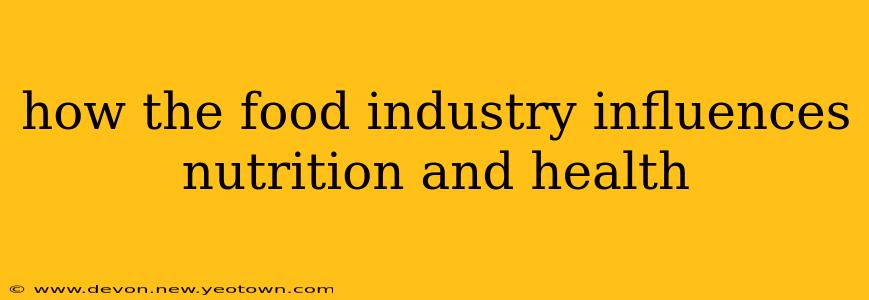The aroma of freshly baked bread, the vibrant colors of a farmer's market, the satisfying crunch of a crisp apple – food is more than just sustenance; it's deeply woven into the fabric of our culture, our emotions, and our health. But the modern food industry, a sprawling behemoth, exerts a powerful influence on what we eat, how much we eat, and ultimately, our nutritional well-being. This isn't a simple good-versus-evil narrative; it's a complex interplay of economic forces, marketing strategies, and individual choices. Let's delve into this fascinating – and often troubling – story.
The Power of Marketing and Branding: Shaping Our Desires
Imagine a world without targeted advertising. Suddenly, the allure of sugary cereals aimed at children, the convenience of processed snacks, and the emotional connection we forge with certain brands would diminish considerably. The food industry invests billions annually in marketing, subtly shaping our perceptions of what constitutes a healthy, desirable meal. Clever packaging, celebrity endorsements, and emotional appeals all work together to influence our food choices, often prioritizing profit over public health.
The Ubiquity of Ultra-Processed Foods: A Modern Conundrum
This isn't about villainizing all processed foods. Canned tomatoes, for instance, offer convenience and nutritional value. However, the rise of ultra-processed foods—items laden with added sugar, salt, unhealthy fats, and artificial ingredients—presents a major challenge. These foods, often cheap and readily available, are engineered to be highly palatable, triggering reward pathways in our brains that encourage overconsumption. The consequence? A global rise in obesity, type 2 diabetes, and other diet-related diseases.
What are ultra-processed foods?
Ultra-processed foods are those that undergo extensive industrial processing, often involving multiple ingredients, additives, and techniques to enhance shelf life, taste, and texture. Think sugary drinks, fast food, packaged snacks, and many ready meals. These foods often lack essential nutrients and contribute to an unbalanced diet.
The Role of Food Pricing and Accessibility: A Matter of Equity
Healthy food isn't always readily accessible or affordable, particularly in low-income communities. The price of fresh fruits and vegetables often surpasses that of cheaper, less nutritious options. This disparity creates a nutritional divide, contributing to health inequalities. Making healthy food choices shouldn't be a luxury; it should be a right.
How does food pricing affect dietary choices?
Higher prices for healthy foods can make them inaccessible to many, forcing individuals to rely on cheaper, often less nutritious alternatives. This creates a cycle of poor nutrition and associated health problems, particularly within vulnerable populations.
The Influence of Food Policy and Regulation: A Balancing Act
Governments play a crucial role in shaping the food landscape through policies, regulations, and subsidies. Subsidies for certain crops, for instance, can indirectly influence the availability and affordability of particular foods. Stronger regulations on added sugar, salt, and unhealthy fats could also significantly impact public health. However, finding the right balance between protecting public health and supporting the food industry remains a complex challenge.
What role do governments play in regulating the food industry?
Governments can implement policies and regulations such as food labeling standards, restrictions on marketing to children, and taxation of unhealthy foods to encourage healthier dietary choices. Subsidies for healthy food production can also increase affordability and accessibility.
The Future of Food and Nutrition: A Call for Collaboration
The relationship between the food industry and our health is multifaceted and ever-evolving. A collaborative approach is needed, involving food producers, policymakers, health professionals, and consumers themselves. This includes promoting sustainable food systems, supporting local farmers, advocating for healthier food policies, and fostering greater food literacy among the public. Ultimately, our collective well-being hinges on making informed choices, demanding better from the food industry, and creating a food system that prioritizes both taste and health.

